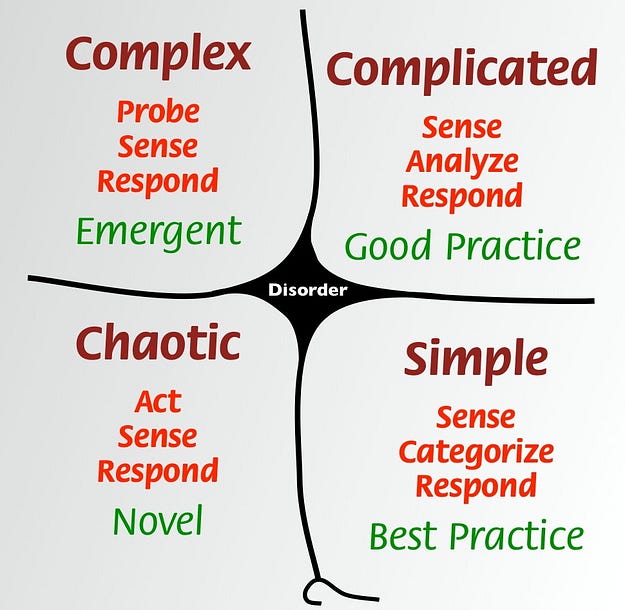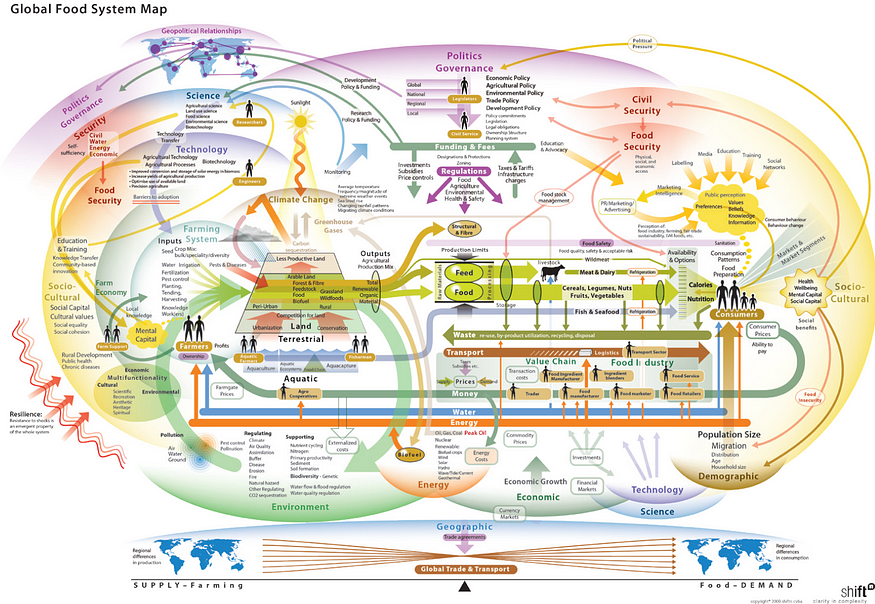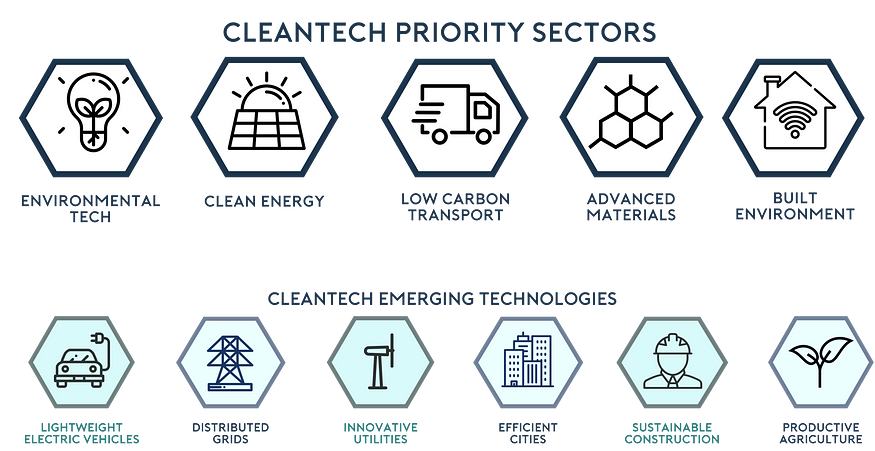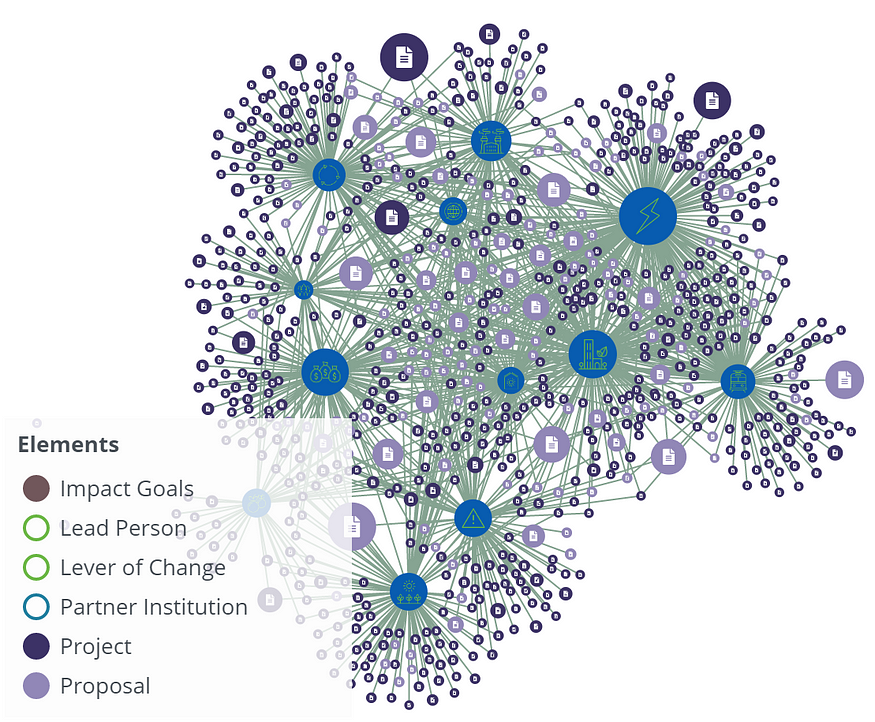Innovating in complexity: From single-point solutions to directional systems innovation
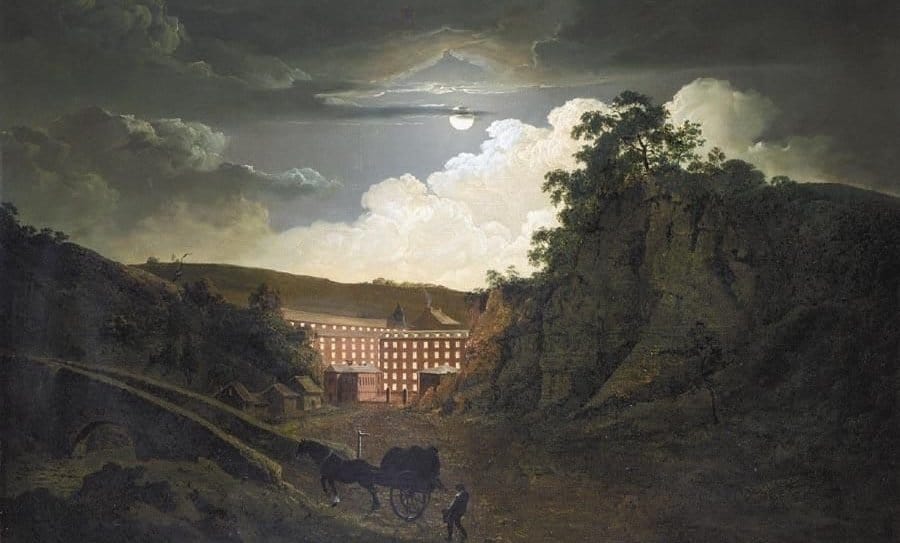
What was the big bang that ushered in the “Industrial Revolution” in 1771? The opening of a cotton spinning mill in the village of Cromford, Derbyshire by the English inventor Richard Arkwright. It was the world’s first industrial installation powered by flowing water.
The “Industrial Revolution” was the first of five technological revolutions in modern history that led to what economist Carlota Perez calls “great surges of development”. It was followed by the “Age of Steam and Railways” (1829–1870s), the “Age of Steel, Electricity and Heavy Engineering” (1875–1910’s), the “Age of Oil, Automobiles and Mass Production” (1908–1970’s) and the “Age of Information and Telecommunications” (since the 1970’s).
As Perez describes, these revolutions share a number of striking features. They all followed a similar rhythm, evolving through a cycle with four successive stages—irruption, frenzy, synergy, and maturity—over roughly 50 years. They also had similarly profound impacts on the world, producing fundamental changes in the socio-technical fabric of society, a new ‘common sense’ economic logic, and ‘golden ages’ of progress and prosperity.
Yet the most intriguing common feature is that they were all triggered by the invention and diffusion of new technologies. In Perez’s model, a “phase of irruption” sets in when the incumbent techno-economic paradigm is nearing exhaustion, creating conditions favourable to the emergence of new niches in which innovations can “install” themselves. Is it any wonder, then, that many people are eagerly awaiting the next technological revolution to solve the most pressing and tangible challenges of the 21st century?
A world used to inventing itself out of crises is desperate for techno-fixes to cope with climate change, hunger and poverty, health and nutrition, environmental pollution, social inequality, and deadly diseases. Just consider how much hope people place in carbon removal technologies to compensate for our delay in reducing greenhouse gas emissions, in genetically modified crops to solve global hunger, and in digital technologies to create a more equal society.
Yet herein lies a fallacy.
Perez’s historical “surges of development” happened during a time when prosperity was equated with monetary wealth. The economic growth that created such wealth was enabled by technical advances such as machines, steam engines, power generators, smelters, mass production lines, and microelectronics—through the singular mechanism of making resource extraction and conversion more productive.
Today’s existential problems will not be resolved by the same logic. As our economies transgress natural boundaries and social breaking points, economic expansion has become the problem rather than the solution. Wealth accumulation is still needed to lift billions of people out of poverty and create a more equal society. Yet it must occur under a radically different paradigm, one that respects the limits of our environment and the needs of our communities.
No single technology can enable this type of growth. The challenges we now face are not technical in nature—they are systemic.
Take climate change. According to the IPCC’s 1.5 Degree Special Report, the world requires rapid and unprecedented transformations not just in energy supply and consumption, but in land-use, urban, infrastructure, and industrial systems in order to avoid the most perilous effects of global warming.
Wind turbines, smart thermostats, and plant-based plastics will be important elements of a more sustainable lifestyle. But working versions of these technologies have been commercially available for decades and yet the global community is still far off track to avoid dangerous climate change.
So where can innovation make the most difference, and what kind of innovation do we now need? Technology-centric ‘innovation as usual’ will provide some of the building blocks of a more prosperous and just future. But what we must learn now is how to weave these technological advances into the fabric of society along with other cultural, institutional, social, and economic innovations.
What lies ahead is unparalleled in ambition and arguably more difficult than anything we have ever attempted before. We simply do not know how to operate our globalised and connected world for zero-carbon outcomes across all domains of society. What we do know, from both theory and practice, is that incremental improvements and single-point solutions are not putting us on track for such transformations—let alone at the required scale and pace. Delivering on the ambitions of the Paris Agreement thus requires us to rethink the dominant models of innovation.
The world as a complex adaptive system
Whenever innovation is called into service to address a problem, understanding the nature of the problem is key. The Cynefin Framework is a popular tool for sorting challenges into four principle contexts, defined by the relationship between cause and effect: Simple, complicated, complex and chaotic.
Simple contexts are the domain of best practice where decision-makers must “sense, categorise, and respond.” Your daily commute is a simple issue because you can rely on your experience—and on Google Maps’ real-time traffic data to optimise your route from home to office.
Complicated contexts are the domain of expertise, where decision-makers can identify right solutions by analysing, investigating and diagnosing. Cars, phones, and computers are complicated—people with appropriate technical training can disassemble, study, and reassemble them.
Complex contexts are the domain of emergence, where there are no best practices or right answers. Forests and markets are complex. We can observe them, intervene with experiments, and try to make sense of what emerges—but we can never fully understand them, let alone predict their behaviour.
Finally, chaotic contexts are the realm of turbulence where no manageable patterns exist and where decision-makers must focus on establishing some degree of order to move the situation from chaos to complexity. A terrorist attack leads to chaos, as does a football game that incites fans to storm the field.
Human civilisation behaves as a complex system. It consists of billions of agents with different ambitions, interests, and values. These agents coordinate their interactions through communities, social constructs (e.g. markets and companies), and institutional regimes (e.g. nation-states and laws)—systems that are fundamentally complex because of the human agency that sits at their core.
Human systems have an additional property: Adaptiveness. Our collective behaviour changes as a result of internal pressures and external forces, in a constant dance with our environment, motivated by our will to survive and prosper.
The most pressing challenges of the 21st century emerge within this complex adaptive super-structure and, by extension, are predominantly of a complex adaptive nature. In such contexts, it is difficult to identify all of the nodes within a system and understand how they relate to and interact with each other. It is even more difficult to understand how the system self-organises and responds to changes in its environment. And it is almost impossible to predict emergent behaviours and non-linear effects.
How do you transform a country’s economy to operate on circular principles? How do you electrify and modally integrate a city’s transportation system? How do you decarbonise an agricultural supply chain? The simplicity of these questions masks the intricacy of their answers.
Shifting the innovation paradigm
Unlocking change in complex adaptive systems requires a shift in the paradigms that sit at the core of our innovation models.
At the EIT Climate Knowledge and Innovation Community (Climate KIC), where I work, we understand this from first-hand experience. For the first nine years of our organisation’s existence, we have tried to address climate change with a heavy emphasis on supply-driven innovation: engaging research and entrepreneurship to develop new climate-positive technologies and products based on a belief that commercial success would produce climate impact. We operationalised this approach through competitive funding calls, using performance indicators weighted toward the creation of new ideas and businesses. The result was a potpourri of solutions in search of markets, customers, and investment.
Through this practice, we have realised that the gravitational force that emerges in such a supply-driven system leads to a techno-centric innovation pipeline characterised by incremental improvements of single-point solutions—and thus rarely to systemic solutions that promise to achieve transformational change.
Indeed, we were not alone in putting our hopes in the creation of the next big thing. Ever since climate change entered the world’s political stage in the 1970’s, the world has treated it as a complicated problem. As a consequence, efforts to stem global warming have mostly focused on developing technical solutions through research and engineering. Just consider how, up until about 2015, the word “cleantech” had been used almost synonymously with the idea of sustainable innovation.
This techno-centric approach has produced many important building blocks of a sustainable future such as renewable energy technologies, advanced batteries, and biofuel production processes. Yet in 2019, climate change is no longer a problem of technology development but of technology diffusion.
Incremental improvements in solar cell efficiency and electric vehicle charging speeds will be welcome, but they will not unlock change at the scale and pace we need. Nor will breakthrough technologies like synthetic fuels and green cement or technologically mature solutions like heat pumps and carbon-neutral polymers reach any meaningful scale based on their current techno-economic merits alone. If we are to unlock the rapid and unprecedented transformations that the IPCC is calling for, we need to shift the paradigm from single-point solutions to directional systems innovation.
At Climate KIC, we define systems innovation as integrated and coordinated interventions in economic, political, technological and social systems and along whole value chains.
This definition implies that we see innovation as not just limited to technological improvements. Instead, we seek to engage all levers of change: policy and regulatory frameworks, financing models, social norms and behaviours, skills and capabilities, citizen participation models, identities and narratives of individuals and collectives, business models, and production and consumption paradigms.
This definition also entails that we intervene in different social domains (e.g. cities, companies, professions), on different governance levels (municipal, regional, national, and supranational), and within different sectors of the economy (e.g. industry, energy, land-use, finance) as well within transversal regimes (e.g. capital markets, education systems, institutions).
We understand that most systems we need to transform behave in complex adaptive ways. This means that there are no right solutions and that deterministic intervention strategies are bound to fail. Instead, we believe that the best way to shift or ‘kick’ these systems is through exploration and experimentation. This is the quintessential learning by doing; testing ourselves forward through real-world experience so that we can ”learn the future into being”.
Our building blocks
Our approach to directional systems innovation rests on three major building blocks:
1) Mission-led
Our starting point is shaping and harnessing the power of the demand side of innovation. Working with governments, corporations, and other challenge owners that share our ambition for transformative action will help to pull through the connected, system-wide solutions we need.
Ambitious demand-side actors have a strong appetite for change and appreciate the full complexity of the problem and the necessary scale for intervention. They are also well-positioned to identify a broad and diverse set of nodes in the systems they aim to transform. This provides them with an edge over supply-focused actors, who tend to see problems through the lens of discrete solutions; a lens that is inevitably narrow and typically focuses on those levers that solution providers can influence through product features, pricing strategies, and marketing plans. In other words, systems-literate challenge owners see and want more.
In our innovation practice, we work with challenge owners to understand the complex nature of their place-based or industry-level innovation problems so that we can jointly design and deliver systemic interventions with transformative potential. We cast these challenges as missions—a useful mental model that calls on all actors of society to contribute, kindles our imagination, and induces us to identify the invisible forces guiding human systems such as values, habits, and identities. Missions thus naturally lead us toward combinations of solutions and their orchestrated deployment, which is coherent with our view of how to best intervene in complex adaptive systems.
2) Portfolio-based
We orchestrate the development and deployment of these interventions in portfolios. Portfolios are collections of deliberately chosen innovation experiments designed with—and delivered through—our community. These experiments—which represent the supply side of innovation—come in the form of diverse and coordinated innovation projects, education programs, start-ups, ecosystem building activities, citizen engagement strategies, and communication initiatives. They focus on different parts of the same problem, on different opportunities to lever change. In sourcing and shaping them, we often venture beyond the mainstream, to the edge of technological progress and social experimentation.
One of the distinguishing features of portfolio-based innovation is that the locus of interest shifts from individual interventions to the aggregate level of the portfolio. We select our experiments not solely on the basis of their individual merit but by assessing the value they add to the portfolio as a whole. In doing so, we are looking for combinatory effects, which arise when new experiments connect with existing activities or when they fill gaps to give us new windows into possible futures. This does not mean that there is no longer any space for single-point solutions—it just means that such single-point solutions must play a role in a larger ensemble, contributing value to the portfolio as a whole.
In designing our portfolios, we seek to maximise the quality of information about the system they produce. We do that because of the inherent uncertainty of complex adaptive systems. Portfolios allow us to explore viable pathways to change, assess transition dynamics, and identify intervention points that exert leverage within the system. Each experiment—in conjunction with the other positions within the portfolio—offers an opportunity to sense-make and learn about how the system works.
By deliberately choosing and connecting our experiments, we endow our whole portfolio of work with multi-dimensionality and fractality. The portfolio is multi-dimensional because we can make sense of it by clustering individual experiments according to different system characteristics: domains of intervention, levers of change, level of coordination, type of activities, contexts, and so forth. It is fractal because the portfolio consists of many sub-portfolios and sub-sub-portfolios. By interrogating different cluster configurations, we can surface and leverage interesting relationships that would otherwise stay hidden.
3) Community-delivered
No single organisation can address humanity’s gravest challenges alone. That’s why we work with close to 400 innovation partners from the private, public, and academic sectors. These partners operate as a diverse community that understands the specific needs and resources of different places and contexts. They bring their own expertise and experience to the systems in which we intervene, in service of our common cause: building collective intelligence.
Mission-led, community-delivered systems innovation requires that we engage with leaders in politics, business, academia, and society. It also requires that we engage individuals and organisations operating outside of the mainstream, in the fringes of society and at the edges of the technological universe. These places hold great promise for producing breakthrough solutions, often through interdisciplinary collisions and serendipitous encounters.
Directional systems innovation in practice
Over the past nine years, we have supported over 1,500 innovation projects, which have led to the creation of more than 360 new products and services. We have also trained more than 17,000 individuals and supported over 1,400 climate-positive start-ups.
Today, our portfolio consists of hundreds of positions, which can be associated with one of five thematic domains: Cities, land-use, materials, finance, and water and marine systems. We have chosen to work in these socio-technical systems because we see them as critical for climate change mitigation and adaptation—and as being in urgent need of transformation. In each of these domains, we direct innovation at all relevant levers of change in pursuit of specific impact goals.
In 2019, we launched a new way of constructing innovation portfolios: Deep Demonstrations. The purpose of this format is to test possible sustainability pathways in highly specific contexts to demonstrate possibilities and enable challenge owners to make better-informed strategic decisions.
We design these engagements in collaboration with such challenge owners and then leverage the full extent of our community to tackle multiple levers of change simultaneously. For instance, we are currently working with the Government of Slovenia on developing and implementing a multi-year/multi-layered innovation action plan to support Slovenia in becoming the world’s first country with a fully circular economy.
Our capability space
A mission-led, portfolio-based, community-delivered approach to directional systems innovation requires a set of distinct capabilities:
Engage: The capability to scope challenges, scout early adopters, structure innovation ecosystems, source and exchange ideas, and cultivate the building blocks of collaboration (including trust and a sense of possibility).
Lead: The capability to develop innovation experiments, build consortia, compose innovation portfolios and design Deep Demonstrations, and create a common voice for climate action in policy and funding.
Empower: The capability to design funding support to suit the purpose of systemic change, unlock innovative and progressive sources of financing, and support capacity building and mindset shifts.
Learn: The capability to measure and make sense of what emerges in the system in order to build the collective intelligence needed to detect momentum and identify leverage points.
Deliver: The capability to deliver change as a community through innovation implementation and scale-up.
In the years ahead, the Climate KIC community will continue its journey of catalysing exponential increases in decarbonisation and resilience through systems innovation. The community is open to ambitious innovators, sharp system thinkers, progressive investors, experienced innovation practitioners, determined public sector officials, and creative voices—and anyone else ready to address the most wicked problem the world has ever faced.

